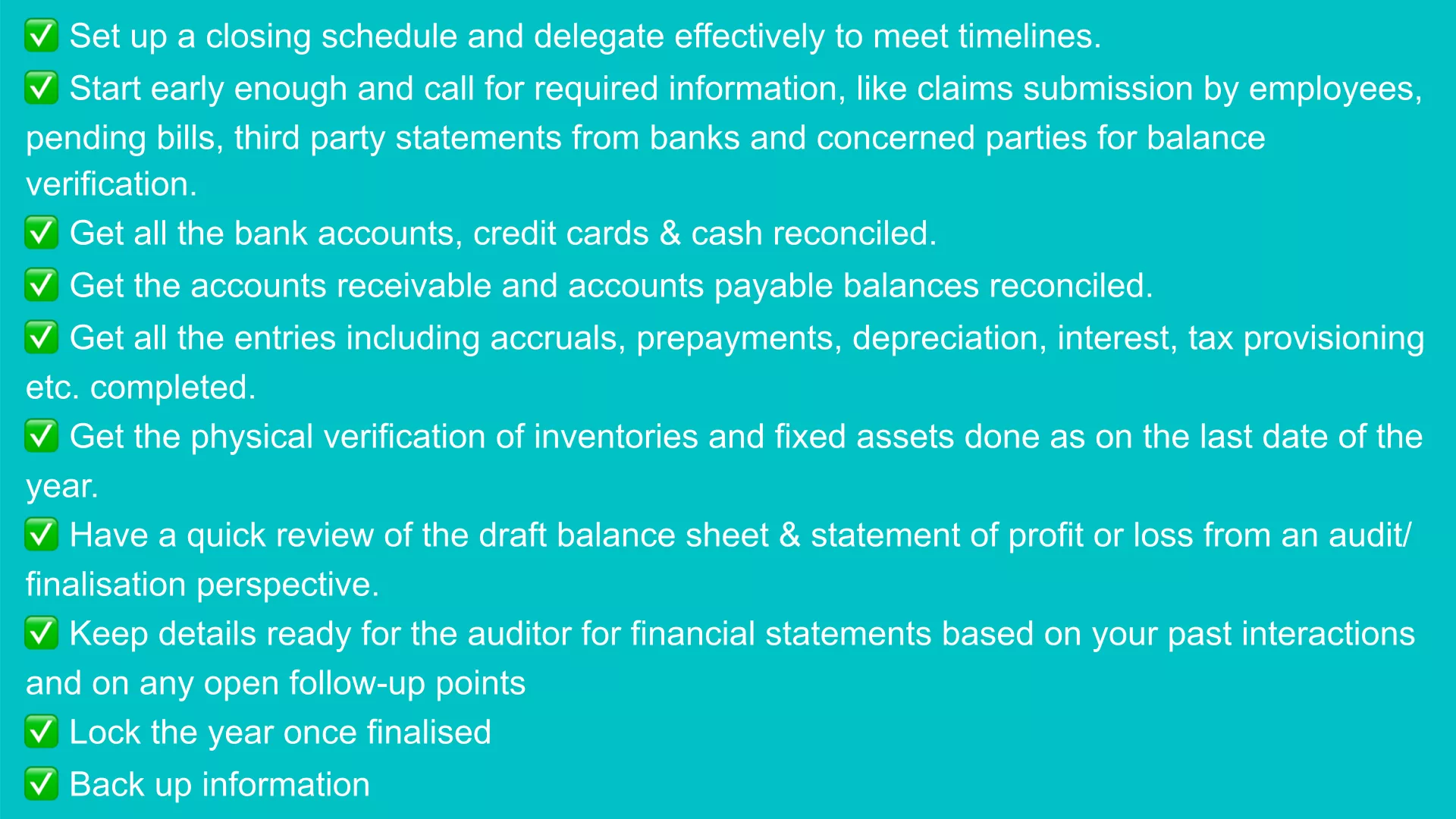Year-End Closing Deadline Approaching: A Step-by-Step Guide
07.03.2023
The year-end closing is a challenging process for the entire accounting department. The accounting team has to put in extended hours to meet deadlines for various year-end tasks such as annual wage statements, VAT returns, and annual corporate tax filings. As a founder or CFO of the company, you are responsible for presenting the yearly financial statements that give a true and fair view to the board and investors. These statements also become a source document for the annual filing of corporate taxes in Switzerland.
Make sure you check these steps off your year-end accounting closing checklist before the year officially comes to a close.
👇YEAR-END ACCOUNTING CHECKLIST👇

Below detailed guidelines will help you set up, plan, and close the year-end in an efficient and effective manner:
1. Set Up a Closing Schedule
List out tasks keeping in view the following:
- Detailed heads of assets and liabilities appearing on the draft balance sheet.
- Detailed heads of revenue and expenses appearing on the draft statement of profit or loss.
- Applicable accounting regulations as per the size of your business and type of entity.
Organise this list, create tasks and action items with timelines, and delegate wherever possible. Discuss this schedule with your team to incorporate their feedback and to clarify any questions or doubts they may have. Your list will cover the following topics.
2. Start Early Enough
Request the in-house desired information by sending emails to all concerned parties at least one month in advance (with follow-up emails every 10 days until year-end) clearly describing the desired actions and the timelines. For example:
- Coordinate with the sales team for the following:
- To get the invoicing done for projects completed and services rendered by 31st December.
- To get details of unbilled revenue as on 31st December.
- Update on the latest status with remarks for action taken and further steps for overdue debtors lying in books as on 31st December. Also, request them to share recommendations for write-offs or the creation of provision for bad debts, if any.
- Request all vertical heads and employees to:
- Ensure submission of the pending purchase and expense invoices relevant to the year pertaining to their vertical to the accounts team within 5-10 days from the end of the year.
- Submit their reimbursement claims involving use of their personal and business credit cards or wallets towards official expenses incurred by them, like travel claims, phone reimbursements with supporting documents i.e., payment proof and bills within 5-10 days from the end of the year.
This exercise will ensure timely submission of the maximum information to the accounting team and its processing within the last month of the year, leaving you with more time to deal with other year-end finalisation tasks.
3. Collate Third-Party Statements
Request the third-party statements as on the last date of the year, such as:
- Download and collect bank statements for all bank accounts, wallets, and credit cards in use by the company like PayPal, Stripe, Revolut, Credit cards, PostFinance, etc.
- If you have investments in equity, debt, mutual funds, crypto on the balance sheet, collect the statements from the respective funds, brokers, and companies to arrive at the fair value of your investments as at the year-end and to compute and book fair value gain/loss for the year.
- Write for balance confirmation to respective parties for validation of balance lying in accounts receivable and accounts payable in your books as on the last day of the year.
- Proactively engage with management, auditors, and colleagues to swiftly close open issues requiring their inputs.
4. Standard Operating Procedures (SOP), Checklist, and Templates
Create standard operating procedures, detailed checklists, and templates customised as per the needs of your business. This will help your team in quick and correct execution without missing out on any important steps and details.
5. Complete the Accounting Entries for the Year
Based on the information collated, complete the accounting entries for all invoices for sale, purchase, expenses, cash, bank, and credit card transactions pertaining to the year.
6. Review Draft P&L
To finalise all income and expenses, start reviewing your draft P&L and cross-check the following aspects if applicable to your entity. You have to pass the necessary closing and adjustment entries based on your findings.
- Revenue: Ensure revenue is recognised as per the terms of the contracts with customers and applicable accounting regulations. Pass required entries for deferred revenue and unbilled revenue.
- Other Income: Cross-check interest income, dividend income, gain or loss on sale of investments, and fair value gain/loss.
- Purchases: Ensure all purchase invoices pertaining to the year are accounted for, and input tax credit as per books is reconciled with VAT returns.
- Closing Stock: Perform physical verification of stocks and reconcile closing values of stock as per cost records and physical verification report.
- Personnel Expenses: Ensure salaries, wages, bonuses, social security benefits, pension, health insurance, accident insurance, and other relevant expenses are accounted for and reconciled with annual wage statements.
- Product Development Expenses: Determine if product development expenses are to be treated as revenue or capital expenditure.
- Sales and Marketing Expenses: Account for all sales and marketing expenses, including prepaid models for ads.
- Legal, Tax, and Financial Consulting Fee: Ensure invoices are received and accrued as per agreements.
- Rent, Insurance, Energy, Telephone, Internet, and Other Expenses: Accrue expenses based on last month’s or average expenses.
- Depreciation: Compute and book depreciation for fixed assets based on their estimated useful life.
- Amortisation: Compute and book amortisation for intangible assets based on their estimated useful life.
- Interest: Cross-check loan terms and pass entries for interest accrual.
- Current Tax: Prepare and review tax computation and complete entries for the provision for tax.
7. Review Draft Balance Sheet
Start reviewing your draft balance sheet and cross-check the following aspects if applicable to your entity. Pass necessary closing and adjustment entries based on your findings.
- Balance with Banks: Cross-check the balance as per bank statements and books. Prepare reconciliation statements for variations.
- Accounts Receivable: Review the accounts receivable balance and ageing report, and create provisions for bad or doubtful debts.
- Fixed Assets Register: Update entries for purchase, sale, and depreciation of fixed assets and match the balance with the fixed asset schedule.
- Investments: Ensure the investment balance as per books matches with holding statements.
- Input Tax Credits/Refunds Due: Match balances with income tax or VAT returns.
- Prepayments: Refer to the prepaid expense schedule and reconcile the balance on your balance sheet.
- Accounts Payable: Review accounts payable balance and ageing report, and make necessary adjustments.
- Deferred Revenue: Match deferred revenue in the balance sheet with the deferred revenue schedule.
- Loans: Validate outstanding loan balances with statements received from respective banks or parties.
8. Lock the Year in Your System
Once all entries are passed and numbers are finalised for the year, lock the year in your accounting system to prevent any inadvertent entries in the previous year.
9. Back Up
Ensure you have a reliable backup system to protect your important accounting information. This can include local backups on your phone or computer, as well as cloud backups for added security.
10. Update Opening Balance
After finalising and closing the accounts, run an update command to carry forward final balances to the next year.
Conclusion
By following this comprehensive year-end closing checklist, you can ensure a smooth and efficient year-end process. This will not only help in presenting accurate financial statements to the board and investors but also aid in meeting compliance requirements for corporate taxes in Switzerland. As a founder or CFO, taking these steps will enable you to manage the year-end closing with confidence and precision.

